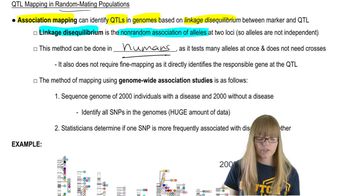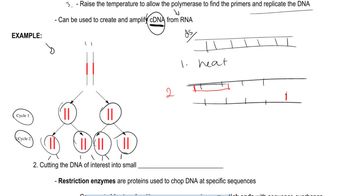Table of contents
- 1. Introduction to Genetics51m
- 2. Mendel's Laws of Inheritance3h 37m
- 3. Extensions to Mendelian Inheritance2h 41m
- 4. Genetic Mapping and Linkage2h 28m
- 5. Genetics of Bacteria and Viruses1h 21m
- 6. Chromosomal Variation1h 48m
- 7. DNA and Chromosome Structure56m
- 8. DNA Replication1h 10m
- 9. Mitosis and Meiosis1h 34m
- 10. Transcription1h 0m
- 11. Translation58m
- 12. Gene Regulation in Prokaryotes1h 19m
- 13. Gene Regulation in Eukaryotes44m
- 14. Genetic Control of Development44m
- 15. Genomes and Genomics1h 50m
- 16. Transposable Elements47m
- 17. Mutation, Repair, and Recombination1h 6m
- 18. Molecular Genetic Tools19m
- 19. Cancer Genetics29m
- 20. Quantitative Genetics1h 26m
- 21. Population Genetics50m
- 22. Evolutionary Genetics29m
18. Molecular Genetic Tools
Genetic Cloning
Problem 32b
Textbook Question
In humans, congenital heart disease is a common birth defect that affects approximately 1 out of 125 live births. Using reverse transcription PCR (RT-PCR) Samir Zaidi and colleagues [(2013) Nature 498:220.223] determined that approximately 10 percent of the cases resulted from point mutations, often involving histone function. To capture products of gene expression in developing hearts, they used oligo(dT) in their reverse transcription protocol.
If one were interested in comparing the quantitative distribution of gene expression in say, the right and left side of a developing heart, how might one proceed using RT-PCR?
 Verified step by step guidance
Verified step by step guidance1
<span>Step 1: Collect tissue samples from both the right and left sides of the developing heart. Ensure that the samples are collected under similar conditions to minimize variability.</span>
<span>Step 2: Isolate total RNA from each of the tissue samples. This involves lysing the cells and using a method such as column purification or phenol-chloroform extraction to obtain the RNA.</span>
<span>Step 3: Use oligo(dT) primers in the reverse transcription step to synthesize cDNA from the mRNA present in the samples. Oligo(dT) primers will bind to the poly-A tail of mRNA, ensuring that only mRNA is reverse transcribed.</span>
<span>Step 4: Perform quantitative PCR (qPCR) on the cDNA using gene-specific primers. This will allow you to quantify the expression levels of specific genes of interest in both the right and left heart samples.</span>
<span>Step 5: Analyze the qPCR data to compare the expression levels of the genes between the right and left sides of the heart. Use appropriate statistical methods to determine if there are significant differences in gene expression.</span>
Recommended similar problem, with video answer:
 Verified Solution
Verified SolutionThis video solution was recommended by our tutors as helpful for the problem above
Video duration:
25sPlay a video:
Was this helpful?
Key Concepts
Here are the essential concepts you must grasp in order to answer the question correctly.
Reverse Transcription PCR (RT-PCR)
RT-PCR is a laboratory technique used to convert RNA into complementary DNA (cDNA) using the enzyme reverse transcriptase. This process allows researchers to amplify specific RNA sequences, making it easier to study gene expression levels. In the context of comparing gene expression in different tissues, RT-PCR can quantify the amount of cDNA produced from RNA samples, providing insights into the relative expression of genes in those tissues.
Recommended video:
Guided course

Eukaryotic Transcription
Gene Expression Analysis
Gene expression analysis involves measuring the activity of genes in a given cell or tissue type, which can reveal how genes are regulated and their functional roles. By comparing gene expression levels between the right and left sides of a developing heart, researchers can identify differences in gene activity that may contribute to the development of congenital heart disease. This analysis often employs quantitative methods, such as RT-PCR, to provide precise measurements of gene expression.
Recommended video:
Guided course

Penetrance and Expressivity
Quantitative Comparison
Quantitative comparison in gene expression studies refers to the process of measuring and comparing the levels of specific mRNA transcripts between different samples. This can be achieved using techniques like RT-PCR, where the amount of amplified cDNA is quantified to determine expression levels. By establishing a baseline or control, researchers can assess how gene expression varies between the right and left sides of the heart, leading to insights into developmental processes and potential abnormalities.
Recommended video:
Guided course

QTL Mapping in Humans

 7:43m
7:43mWatch next
Master Genetic Cloning with a bite sized video explanation from Kylia Goodner
Start learningRelated Videos
Related Practice


